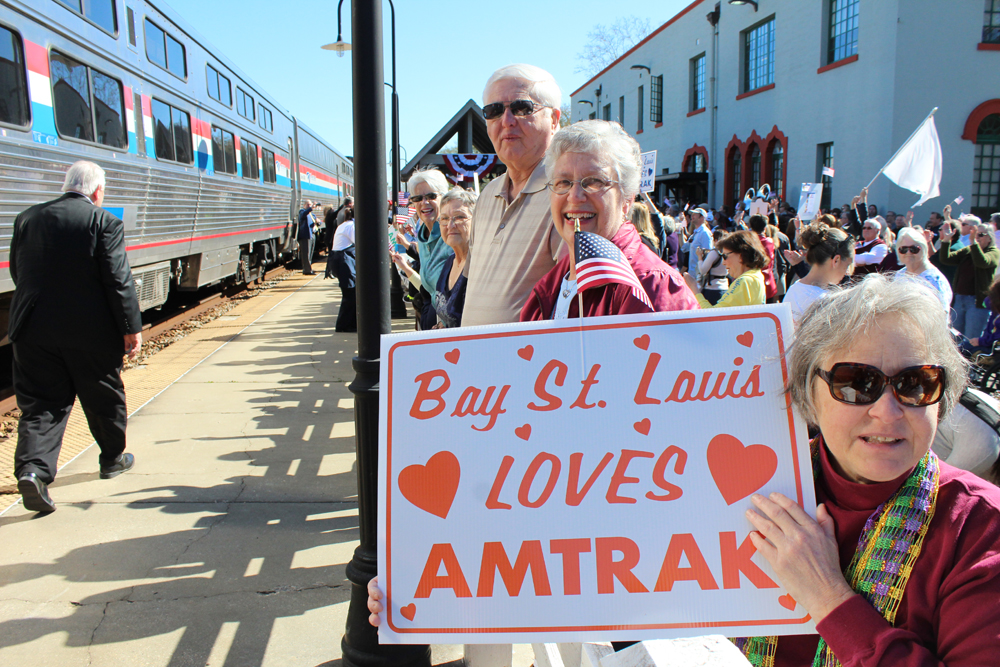
Amtrak will square off against CSX Transportation, Norfolk Southern, and the Port of Mobile, Ala., during Surface Transportation Board hearings this month and next regarding proposed Gulf Coast passenger service.
Technically, this is about Amtrak’s disagreement with the freight railroads over starting a pair of daily round trips between Mobile, Ala., and New Orleans. But what’s really at stake is Amtrak’s right to access host railroads and how to determine what capacity projects are necessary to support passenger trains and ensure they don’t snarl freight traffic.
Amtrak and host railroads typically work out agreements on new or expanded service. They collaborate on a traffic study that helps determine what capacity improvements may be required. Amtrak picks up the tab, track improvements are made, and then service begins. Simple, right?
Except that none of that happened on the Gulf Coast despite years of study. So now Amtrak is at loggerheads with CSX, NS, and the port. Last year Amtrak pulled out of a much-delayed rail traffic control study and told the host railroads that it wanted to launch service on Jan. 1, 2022 – with or without capacity improvements. After CSX and NS said no, Amtrak last March hauled them before the STB. CSX and NS say at least $405 million in improvements would be required so that passenger trains would not interfere with freights. And now regulators have to sort out the mess.
The STB will get an earful of public comments on Feb. 15 and 16. (Among those on the agenda: Wick Moorman, former CEO of Norfolk Southern and Amtrak, who should provide a unique perspective.) Then on March 9 the parties involved – Amtrak on one side and CSX, NS, and Alabama port officials on the other – will make their case to the STB.
Perish the thought, but if I were on the STB here are the questions I would want answered.
For All Parties:

Q. It shouldn’t take six years to figure out what’s required to begin new passenger service. Why, exactly, are you before the board when you should have worked this out years ago?
Q. Pan Am Railways President David A. Fink has written to the board about how his railroad once butted heads with Amtrak and the Northern New England Passenger Authority over Downeaster service. Then he notes that Pan Am, Amtrak, and the passenger authority reached an agreement on track maintenance and how to handle new service proposals. Fink then adds a crucial point: “As a result, trains have operated fluidly and on time, necessary infrastructure has been constructed and both the intercity passenger and freight service have thrived. In short, negotiation among equals, rather than litigation between adversaries, has proven to be a successful model to allow intercity passenger and freight rail service to coexist.”
Do you believe negotiation, rather than litigation, should be a model for how passenger service can be introduced on host railroads? If so, why not settle this instead of having the board impose a precedent-setting decision that you may not like?

Q. There are seven movable bridges between Mobile and New Orleans, each of which is opened frequently to allow unscheduled marine traffic to pass. The rail traffic control study prepared for CSX and NS correctly notes that numerous daily bridge openings are a wildcard that would cause significant delays. Yet around the country railroads have reached agreements with the Coast Guard that give priority to approaching passenger trains. Certainly with just four passenger trains per day, and the support of U.S. Sen. Roger Wicker, R.-Miss., this could be accomplished. But the freight railroads’ traffic study does not consider this inexpensive option to increase reliability. And Amtrak apparently has not sought bridge agreements for Mobile-New Orleans service. Why not, especially when obtaining an agreement is a long and involved process?
For Amtrak:
Q. Today’s CSX New Orleans & Mobile subdivision is a railroad straight out of the 1950s. Nearly all of the passing sidings are short, feature low-speed turnouts at each end, and are unsignaled. So trains enter and exit the sidings at 15 mph. Today’s longer freights often run over siding length, which creates few if any places to stage meets. What’s more, the track joints on the seven movable bridges don’t support passenger-train speeds. Given all this, why launch service before capacity projects and track and signal improvements are made? Call me old school, but shouldn’t you do things the right way or not at all?
Q. The proposed Amtrak schedules are not competitive with the highway. The evening departure from New Orleans, for example, would take 3 hours and 23 minutes to reach Mobile. It only takes about 2 hours and 15 minutes to drive between the two cities via Interstate 10. How will you lure people out of their cars with service that’s 50% longer than driving? And how will you turn first-time passengers into return customers when it’s likely that, without capital improvements, your trains would arrive late more often than not? Is passenger service that’s slow and unreliable a winning combination?
For CSX:
Q. Host railroads typically show all their cards when negotiating with Amtrak. That means sharing daily train counts and schedules, which are key ingredients to the rail traffic control study that helps determine capacity needs. If the host railroad has capacity for X more trains on its line before passenger service is added, the expectation is that capacity improvements will be made so that the host railroad still has capacity for X more trains after Amtrak begins service. This level of transparency instills confidence in the process. Yet CSX (and NS) have opposed public disclosure of even limited train data. Railroads are an open factory, where anyone can watch operations and an internet search can yield all sorts of information – including daily train counts from the FRA grade-crossing database. And has CSX read its own Pan Am Railways merger application? It goes into great detail on its operations in New England and neighboring New York, including train symbols, types of traffic, and days of operation. Why not be transparent on the Gulf Coast, as the Department of Transportation and Federal Railroad Administration recommend? And shouldn’t you expect some level of public scrutiny when recommending that taxpayers fork out $405 million to support new passenger service?
Q. We hear all the time that Precision Scheduled Railroading creates capacity by moving freight on fewer but longer trains. CSX operates three or four road freights per day each way between Mobile and New Orleans. When trains are over siding length, CSX tends to run directional fleets. Westbound traffic is held at Mobile to await eastbounds from New Orleans and vice versa. Doesn’t this type of operation unreasonably delay freight traffic more than any four-car Amtrak passenger train possibly could?
For CSX and NS:
Q. The New Orleans gateway is notoriously unpredictable. The railroads’ own rebuttal filing with the board notes that, “Even if CSXT and NSR were to design a perfect timetable for operating this line, it would quickly be rendered moot by the randomness that characterizes freight railroading in the United States.” Considering this, how could any scheduled passenger operation unreasonably interfere with freight traffic that is, by definition, random? And would operating freight trains closer to schedule reduce the amount of capacity improvements that need to be made?
You can reach Bill Stephens at bybillstephens@gmail.com and follow him on LinkedIn and Twitter @bybillstephens






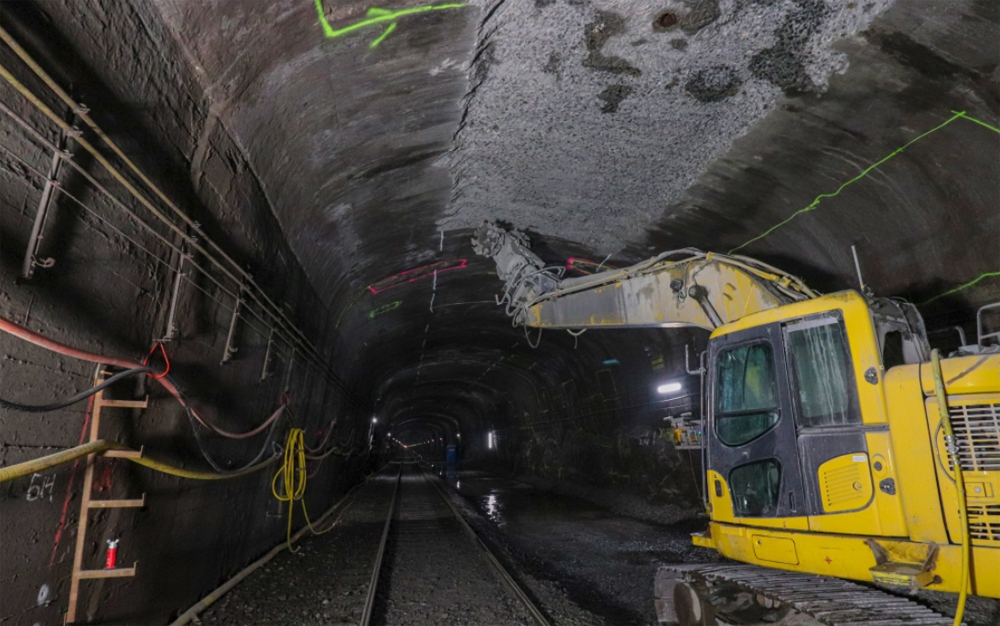
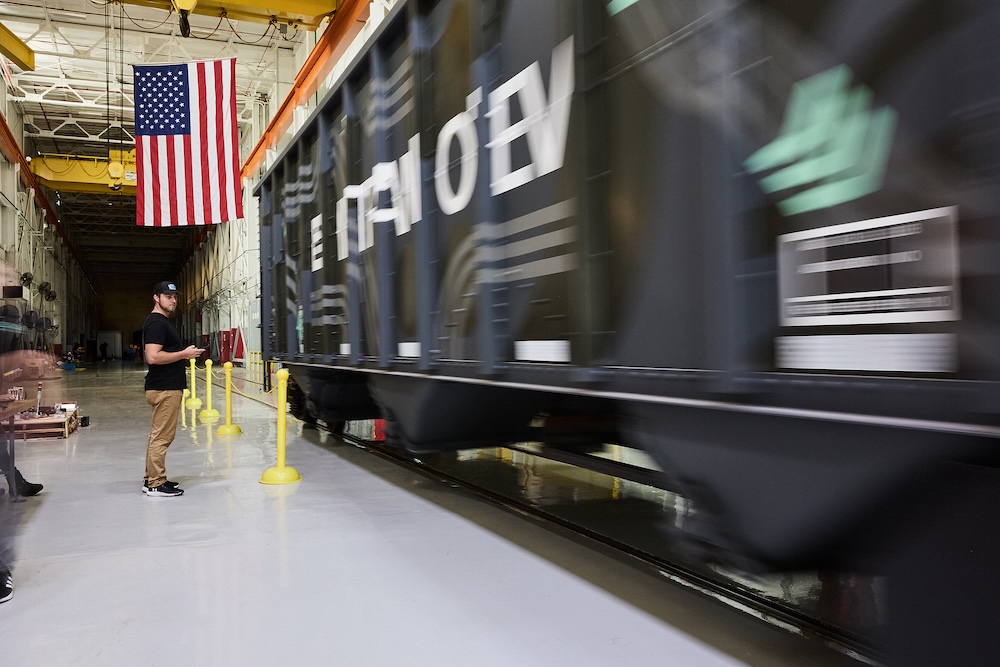
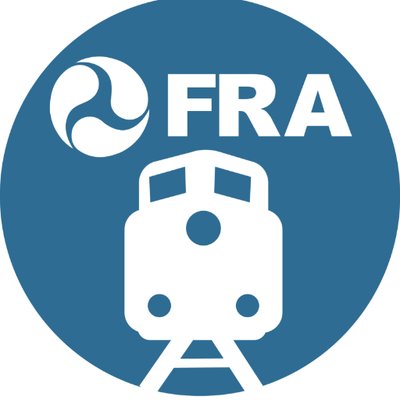
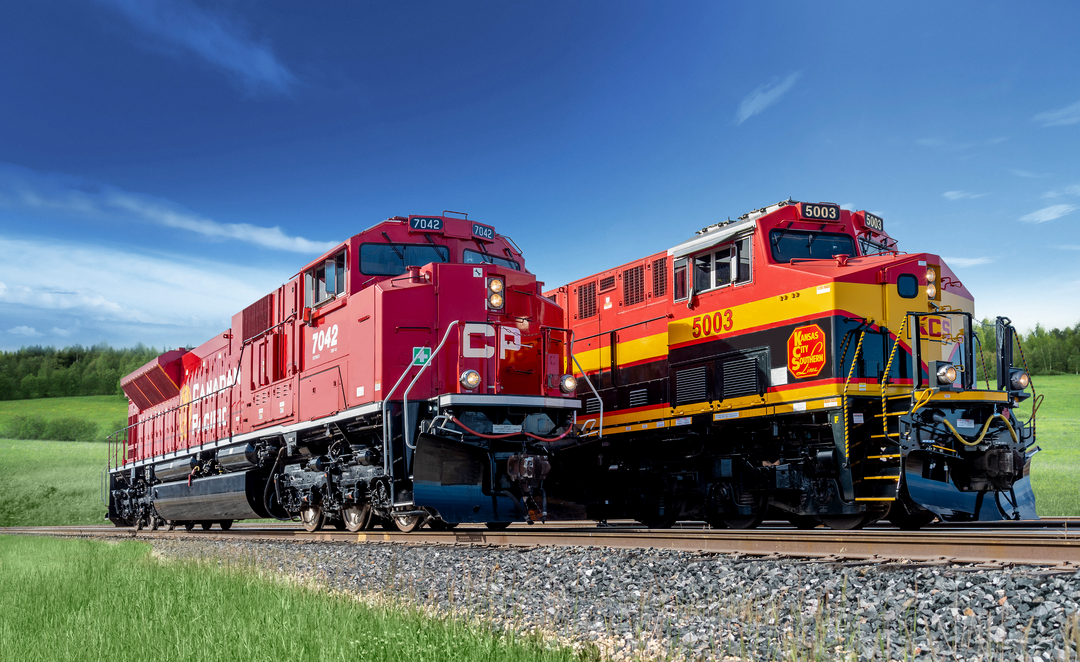




Bill Stephens: you should volunteer as a witness at the STB hearing and ask these questions. That might make the hearing a lively experience.
I remember in the 1940-50’s railroads ran their passenger trains ON TIME, in spite of the fact there were normally at least 4 per day mixed in with a lot of freight. Yes shorter freights but also shorter sidings but, many more of them. Todays track has been rationalized to approx 1 passing track per 10-12 miles, albeit some much longer . In the 1950’s railroads generally took out every other siding and lengthened the remaining ones. There is a big difference in hauling 90 cars vs 240. It takes longer to enter and leave sidings and get up to speed than it did before. The point of all this is the RAILROADS did this to themselves but want Amtrak to help bail them out making their track more fluid.
Originally I wondered what all the fuss was about with only one passenger train a day each way but, now I see it is 2 each way per day. Even at only 59 MPH that will have an effect on monster freights. The question is truly how much the long trains are delayed. I think we all need to remember Amtrak operated on these tracks for years until the boat/bridge collision. So it certainly can be done.
I see this mostly as the old railroad trick of forcing Amtrak to give big bucks to the railroads as they did when Amtrak was formed. Greed, more money, a form of blackmail is at the heart of it.
From all that I hear CSX runs about 8 trains per day over this route. A day is 24 hours. So adding 4 trains would bring the count to 12 trains per 24 hours. CSX can not dispatch a line with 12 trains per 24 hours? Need new management. And with PSR shouldn’t the freight trains run on some kind of schedule?
The unknown is the moviable bridge opening. Over the long term once Amtrak gets their trains moving the bridge with the most openings should be replaced with a much higher bridge. Since this is for tow boats the heigth above the hi water line might only be 75 to 100 feet. Amtrak, CSX and the Feds would all contrubute money for the project.
I think CSX needs better management. I keep voting against the BOD but they still no change.
Bill have the fees Amtrak pays the freight railroads for the right to use operate over their routes ever increased since 04/01/1971? For inflation? I know the Capitol Corridor JPA pays UP additional premiums to keep the tracks at class VI standards and pays incentive bonuses to dispatch them such that their OTP performance consistently stays at, or above, 95%(?). Perhaps, if Amtrak in wanting to initiate new services (or even over the existing network) were to pay the RRs more for operations , then they RRs might be willing compromise on some of the capital improvements, and eventually we might see that “happy cooperation” David Fink mentions. By bringing some money to the table – The “carrot approach”, Amtrak might be scene as a customer, instead of a nuisance? Far better in the long run then “the stock approach”!
I believe timing is an issue; get a partial service running as quickly as possible before the Administration loses interest in infrastructure and while Congress is Dem controlled. The new Amtrak management needs a “win” now to seen as creditable rather than “a bunch of people playing with trains.”
We have no transportation policy in this country for many (in my opinion) not good reasons. So we are always running up gains ad hoc decisions and conflicts. Maybe if we tried to work together for the good of all the country these ideas or proposals would not always lead to a winner and looser, and we would actually get something done. …Like we used to.
1. Read http://zierke.com/shasta_route to understand how we got to our current condition. Hans-Joachim Zierke is a German in part explaining North American railroading to Europeans. In 2005 he noted that today’s railroads are the survivors in a tough and brutal environment, unlike the situation on I5, snow learing is the private hobby of the Central Oregon and Pacific and until trucks are made to pay their full way thee is little point in investing for relatively short haul time sensitive service.
2. Get either an employee timetable for the post-war 1940s CNW Chicago -Milwaukee in the period where the Commuter 400 had a speed record or an employee timetable on the Via/CN line from summer 1989 to see what track speeds are needed to provide highway competitive passenger service with stops every 10 – 30 miles.
The RRs don’t want to be bothered with passenger trains, so they are doing everything they can to fight this new service. If it is forced on them, they want Amtrak to totally rebuild their trackage.
If that’s true, and I hope it is, then the railroads are correct. Most of Amtrak is a flat out waste of money.
Bill, yours are great questions and comments for all parties. Here’s another that I propose for Amtrak: Why dead-end the service at Mobile? Do you have long-range plans to extend passenger service to either Montgomery/Birmingham or Jacksonville? Or even Nashville/Louisville and on up into the Midwest? Wouldn’t these significantly increase the utility of the Mobile-New Orleans rail segment? And for the CSX (and other freight railroads as well), what is your position regarding such extensive long-range potential for expanded Amtrak service?
The long term goal, as I understand it, is to continue negotiations after this whole situation is dealt with so that either the Sunset Limited or City of New Orleans can be extended from New Orleans to Orlando via Mobile and Jacksonville. That came about as a study completed almost a decade ago, but it would be nice to see nonetheless.
The vehement opposition by NS and CSX is simple… avoid any precedent that allows development of a viable national passenger rail alternative. Where could be next? the executives think. Contrasting this with PanAm Railways doesn’t hit on the fact that passenger services pre-existed CSX’s attempt to monopolize freight service into New England. Acquiring that regional freight monopoly is worth far more than a few Amtrak trains into Maine. I’ll bet passenger trains on the B&A would elicit rabid CSX opposition.
This also emphasizes the utter failure of railroad deregulation. How else does one answer the fact that neither NS or CSX has bothered to invest in capacity additions? The sidings were likely built to fit 1950s or 60s freight trains. They brag about CapEx, but it is mostly replacement. How about that “Crescent Corridor”? Quite an accomplishment… oh wait!
Here in upstate NY, CSX stonewalled any meaningful speed or reliabilty improvements where Amtrak operates, with the complicity of the Cuomo administration. Hopefully something positive can soon happen. All we’ve seen is construction of a few single track passenger stations; capacity constraints baked in the cake!
The class 1s were all chartered to serve the public. What has happened in the past 40 years has been the gutting of American infrastructure and manufacturing. The executives and hedgies stuff their pockets, while the workers get worsening conditions and the public gets poor rail service and clogged highways. This is the same attitude of “the public be damned”, but the media never says it, do they?
GREG – Your analysis is correct. The rail system (infrastructure and management policies both) has changed in the fifty-one years since Amtrak began. In 1971, we had 1950’s-style railroads – bumpy double track, hand-thrown sitches on some passenger lines, rotting-away depots staffed by ticket sellers who also dispatched their blocks. That’s what I saw in Ann Arbor on the Michigan Central when I attended U-M in the years running up to Amtrak. Now we have glass-smooth single iron, CTC, unstaffed stations. In 1971, the railroads were bankrupt and they were falling apart — but it was a system designed to move both freight and passenger trains, and for freight trains make local set-offs and pick-ups at lineside industry.
What do we have now? I read TRAINS MAGAZINE monthly, I read this news site daily, I go to watch trains … how would I describe today’s railroads? I’m reminded of that Civil War story. After the Battle of Shiloh in the spring of 1862, Grant continued south toward Corinth, Mississippi and its critical railroad running east and west. The Confederates ran the same train back and forth over the line, loudly blowing its whistle, to confuse the Yankee army into thinking more and more troops were arriving. That’s what I think todays railroads are doing — pretending to run trains
For those who question running a train when schedule times do not meet driving times. I would reiterate Michael Barnard’s points. Also and maybe more importantly not everyone owns an automobile or wants to drive. As our population ages and as more younger people choose or can not afford a car, we need to offer other mobility options. Indeed, the gulf coast of AL and MI are increasingly being seen as affordable attractive options for retirees. And this is before mentioning the environmental benefits of offering more train service.
In any case, Bill Stephens questions were insightful and helped educate me on the issues on all sides. Thanks so much.
“… Bill Stephens’ questions were insightful and helped educate..on the issues on all sides”. Amen to that. Whenever Mr. Stephens tackles a subject the reader comes away knowing and understanding a whole lot more on the subject than they did before. I started reading his columns back when he was covering the Conrail carve-up and I was hooked.
The last time on the Gulf Coast was revealing. From Pensacola – Lake Charles the % of population owning autos was as low as any other place I travelled. We may find that the ability to travel between these first cities may be higher per capita than other locations
How fast a train goes is of little meaning. A train will never beat driving, as people driving leave when they want to leave – not on the train’s schedule – and both the origin and the destination are exactly where the train goes. Otherwise driving is faster and especially fr more than one person traveling, cheaper.
So a train only works in circumstances such as these: the peson can’t drive or doesn’t want to drive (weather, traffic, etc.), the parking at the destination is unforvorable (the downtown of a large city such as Chicago, New York or Boston), or the person finds driving fatiguing, dangerous or uncomfortable. Or there might be oddball, one-off cases such as meeting someone who has a car so your own car would be a liability at the destination. Those are all legitimate reasons for taking the train, but in almost none of those cases does the speed of the train matter one way or the other.
Random could also describe Amtak’s LD service, which could be every day, every other day, or every third day. There is much more to this story. Cheers.
Re: Siding length. The siding only needs to be as long as the shortest train making the meet. In other words, if CSX wants to run monster trains that are too long for their sidings, then lengthening the sidings is CSX’s problem, not Amtrak’s.
CSX’s “Problem” will become our expense. They’ll have to cover the cost with their freight charges. It’s important to remember that the end user pays all costs. So it’s going to come right through to us in one way on another.
Maybe they should take some their record profits and reinvest in the physical plant, like the railroads used to do before they became beholden to Wall Street and the all mighty OR. It’s a law, they have to carry Amtrak, either we put some teeth behind the law or let private enterprise ignore Federal laws…you can’t have your cake and eat it too.
There’s no “Maybe” about it. To make the investments you favor they’ll do an analysis comparing the cost to the projected future discounted cash flow. It’s discounted for two reasons: 1) It’s in the future and a dollar today is worth more than a dollar 10 years from now, and 2) the projected cash flow is uncertain and must be discounted to allow for that. Nobody knows what things will be like in 10 years.
CSX won’t build and invest without reason. Any project must have a favorable return on invested capital. Otherwise, they’ll just be throwing money away.
If they have excess cash and cannot find a place to invest it with the required return they should pay it out to their shareholders. Those shareholders can then invest it in projects that do have a decent return on investment. That will benefit us all.
I agree with Mr. Strawbridge. Where are the legitimate studies that show there is a demand for this service and do the studies include the participants being told the train could take at least an hour longer than driving [and probably longer than express bus service]? If there’s nothing other than the hope “If we build it, they will come” than I’d tell Amtrak to come back once they have more evidence of a market for the service.
I wonder if Amtrak is pushing this to secure more southern votes in DC so they can get more support for NEC upgrades.
I don’t know, the half dozen studies done by the Southern Rail Collation that wants to start the service maybe? Perhaps those are the studies you’re asking about…Google is your friend, but I didn’t have to even search Google because of following this site and several other online railroading magazines(specifically ones that talk about the business side of things).
Bill, you can’t be serious when you raise the issue of comparative times between Amtrak and driving the same trip. Check the schedules between any major city pairs Amtrak operates between. If the intent is to justify any Amtrak service because it’s faster or at least equal to, the time it takes to drive the same route by car, then forget it. Name me an Amtrak route that achieves that.
According to Google maps, at this very moment I can drive from my home in a northern suburb of Dallas to San Antonio in just over 5 hours. The same trip via Amtrak from downtown Dallas to San Antonio is 10 hours and 10 minutes. And virtually any other city pair combination on the Texas Eagle is the same way.
So, just what is the demand for this passenger service? The people in that area seem to get along just fine without it.
There are two points: First, just because people can get along without service does not mean that this their preference. Second, there are also people who are outside the New Orleans-Mobile corridor who would visit more if there were better transportation alternatives.
“Preference?” “More People Visiting?” If folks want to ride the train they should durn well pay for the total cost. Otherwise, they can just stay home. Other people shouldn’t be taxed to pay for their “Preference” or “Visit”.
Going along with your thinking, the part of my taxes that support air travel should be returned to me. The same thinking should apply to river traffic too.
I fully agree with Mr. Bolsega. Transportation is an economic activity and no economic activity should receive a subsidy. Such subsidies just screw up the economy.
I assume you take full advantage of the roads that the rest of us taxpayers pay for, and have no problem using other people’s money for your transportation use, since the fuel tax only covers about 60% of road costs, so why don’t YOU stay home? Based on your twisted logic, you “durn well” should be paying a lot more for road usage and airfare. Stick to playing with model trains and let real transportation get handled by people who actually understand how taxes and public policy work.
Mark Conway – you are not going to tell me what to do or say.
I am not a model railroader. I do hold an MS in transportation from Northwestern along with a BA in political science from the University of Illinois and an MBA from Loyola-Chicago.
I worked in rail transportation for years. I will not sit down and shut up. This passenger proposal for service between Mobile and New Orleans is foolish. It’s going to be worse than a waste of our money. It will disrupt freight service and that will be harmful to the American economy and the American people.
The Interstate Highways should be toll roads and receive no general tax revenues.
What makes you think you’re more qualified to address this issue than I am?
There is no point to starting New Orleans-Mobile passenger service unless there is an agreement among the parties to install CTC and track upgrades to allow 79 mph speeds. A rail schedule over an hour longer than highway is unacceptable.
This line has CTC and PTC installed on it. It also has powers electric switch machines at the ends of sidings where meets occur. The sidings are unfortunately too short for today’s PSR monster trains. I also know of at least 6 trains that run this route daily because they end up on the subdivision near me (Q601/602, Q605/606, Q526/527).